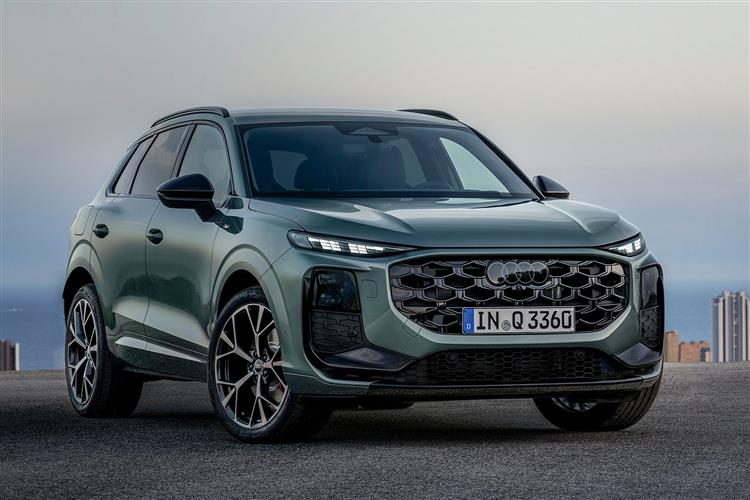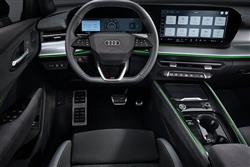BREAKING THREE (some text hidden) --NONE--
By Jonathan Crouch
Audi's third generation Q3 breaks free from the conservative vibe of its predecessors. Jonathan Crouch takes a look
Ten Second Reviewword count: 50
With this MK3 version of their Q3, Audi's third attempt at creating a really premium small SUV is probably their most convincing yet. There's all the electrification you really need. While inside, you'll feel like you're in a more premium kind of car. And in many ways, you will be.
Backgroundword count: 169
Good things often come in little packages. The Q3 compact SUV has certainly been good for Audi, with over 2 million sold since the first generation model's launch back in 2011, a number heavily contributed to by the MK2 design which followed in 2018. So what of this third generation version, announced in mid-2025, built at the brand's Hungarian factory in Gyor and heavily based on a close VW Group rival, the CUPRA Terramar. As before, it's essentially an SUV version of Audi's A3 small hatch, so gets the same platform and powertrains (which don't include an EV version; only a PHEV). But the styling and interior are very different from the A3 because this is the first more compact Audi model to feature the brand's latest generation style of design. As before, its key segment targets are the Mercedes GLA and the BMW X1, but likely customers may also be looking at upper-spec versions of models like the Honda HR-V, the Alfa Romeo Junior and the Lexus LBX.
Engines and Tech Specword count: 235
Audi has committed to put a bit more effort into its combustion powertrains for the remainder of this decade. But that switch away from an EV-only engineering focus came too late to benefit this third generation Q3, which persists with a similar set of combustion drivetrains to those used by last versions of its predecessor. These even include the brand's usual 150PS 2.0 TDI diesel, which still sells alongside the 150PS 1.5 TFSI mild hybrid petrol unit most customers will choose. Auto transmission is now mandatory - the usual dual clutch seven-speed s tronic set-up for conventionally-engined models. Disappointingly, the Q3 doesn't get the advanced 2.0-litre e-hybrid PHEV drivetrain we've seen in the larger Q5. Just a further developed version of the previous Plug-in Hybrid petrol set-up borrowed from the A3, which sees the TFSI model's 1.5-litre four cylinder unit mated with six-speed dual clutch transmission and a 25.7kWh battery offering a (much increased) EV range of up to 74.4 miles. The Q3 e-hybrid's peak power is 272PS, with 400Nm of torque. A pair of conventional 2.0 TFSI petrol units round out the range, with 204PS or 265PS - both with quattro 4WD. All other Q3s are front-driven, with all models based on the same MQB platform as the A3 Sportback. There are three suspension set-ups; standard steel springs; firmer passive sport suspension for top models; and an optional adaptive set-up with twin valve dampers.
To see the full road test text contact us on 0330 0020 227
Pictures (high res disabled)

.jpg)
|
.jpg)
|
.jpg)
| |||
.jpg)
|
.jpg)
|
.jpg)
| |||
.jpg)
|
.jpg)
|
.jpg)
| |||

|
Statistics (subset of data only)
Min |
Max |
|
Price: |
£38,300.00 (At 29 Aug 2025, SUV TFSI 150PS Sport) |
£52,850.00 (At 29 Aug 2025, Sportback e-Hybrid 272PS Edition 1) |
CO2 (g/km): |
40 (e-Hybrid) |
149 (2.0 TFSI) |
Max Speed (mph): |
129 (2.0 TDI) |
149 (2.0 TFSI) |
0-62 mph (s): |
9.2 (2.0 TDI) |
5.7 (2.0 TFSI) |
Electric WLTP-Rated Driving Range (miles): |
74 |
|
Combined Mpg: |
33.2 (2.0 TFSI) |
166.2 (e-Hybrid) |
Length (mm): |
4485 |
|
Width (mm): |
1856 |
|
Height (mm): |
1585 |
|
... and 3 other stats available | ||



